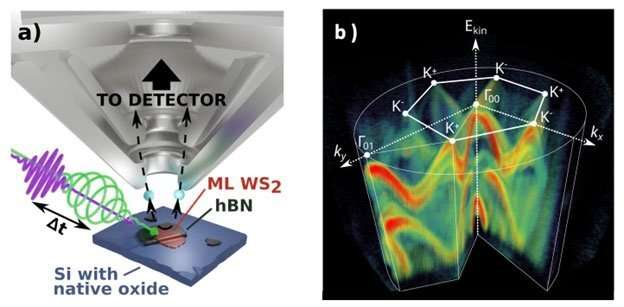
When certain semiconductors absorb light, they can form excitons, which are particle pairs consisting of an electron bound to an electron hole. Two-dimensional crystals of tungsten disulfide (WS2) have unique exciton states that cannot be found in other materials. However, these states have short lifetimes and can quickly transition from one state to another.
Scientists have developed an innovative approach to capture separate images of these individual quantum states. By tracking these quantum states, researchers have discovered that the coupling mechanisms responsible for mixing the states may not completely align with current theories.
Scientists are highly interested in transition metal dichalcogenides, a family of crystals that includes tungsten disulfide, because they exhibit strong light absorption despite their incredibly thin structure. These crystals could be used to create nanoscale solar cells or electronic sensors. With the introduction of a new technique called time-resolved momentum microscopy, researchers can now better observe and understand the transitions between different exciton quantum states. This technique has broad applications, allowing scientists to examine other next-generation materials and devices under a momentum microscope to gain insights into their functionality.
In monolayer transition metal dichalcogenides (TMDs) like WS2, various light-induced exciton states can form under different conditions. Altering the wavelength or power of the incident light, as well as the crystal’s temperature, can lead to the formation or persistence of different exciton states. Circularly polarized light, where the electric field direction rotates around the direction of the light wave, can selectively generate excitons with specific quantum spin configurations within a particular set of energy bands.
Researchers at Stony Brook University have developed a unique instrument to directly visualize this effect under different ultrafast light excitation conditions and to distinguish the complex mixture of quantum states that can arise.
Recently published in Physical Review Letters, these new findings demonstrate how the binding force between an electron and electron hole in an exciton also contributes to rapid coupling, or mixing, of different exciton states. The researchers have shown that this effect leads to the mixing of excitons with different spin configurations while still conserving both energy and momentum during the coupling process.
Surprisingly, the results revealed that the rate of exciton mixing is independent of the exciton energies, contrary to previous predictions. This study provides crucial experimental support for existing theories of exciton coupling in TMDs while also shedding light on important discrepancies. Understanding the interplay between these exciton states is a significant step towards harnessing the potential of TMDs for nanotechnology and quantum sensing.
More information:
Alice Kunin et al, Momentum-Resolved Exciton Coupling and Valley Polarization Dynamics in Monolayer WS2, Physical Review Letters (2023). DOI: 10.1103/PhysRevLett.130.046202
Citation:
Directly imaging quantum states in two-dimensional materials (2023, June 20)
retrieved 20 June 2023
from https://phys.org/news/2023-06-imaging-quantum-states-two-dimensional-materials.html
This document is subject to copyright. Apart from any fair dealing for the purpose of private study or research, no
part may be reproduced without the written permission. The content is provided for information purposes only.
Denial of responsibility! TechCodex is an automatic aggregator of the all world’s media. In each content, the hyperlink to the primary source is specified. All trademarks belong to their rightful owners, and all materials to their authors. For any complaint, please reach us at – [email protected]. We will take necessary action within 24 hours.

Jessica Irvine is a tech enthusiast specializing in gadgets. From smart home devices to cutting-edge electronics, Jessica explores the world of consumer tech, offering readers comprehensive reviews, hands-on experiences, and expert insights into the coolest and most innovative gadgets on the market.


